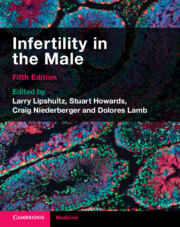Book contents
- Infertility in the Male
- Infertility in the Male
- Copyright page
- Contents
- Contributors
- Foreword
- Abbreviations
- Introduction
- Section 1 Scientific Foundations of Male Infertility
- Section 2 Clinical Evaluation of the Infertile Male
- Section 3 Laboratory Diagnosis of Male Infertility
- Section 4 Treatment of Male Infertility
- Chapter 21 Medical Treatment of Male Infertility
- Chapter 22 Surgery to Improve Sperm Delivery
- Chapter 23 Sperm Retrieval Surgery
- Chapter 24 The Use of Sperm in Medically Assisted Reproduction
- Chapter 25 Male Oncofertility – Considerations for Fertility Preservation and Restoration
- Chapter 26 Male Contraception
- Chapter 27 Future Directions in Male Infertility
- Section 5 Health Care Systems and Culture
- Index
- References
Chapter 26 - Male Contraception
from Section 4 - Treatment of Male Infertility
Published online by Cambridge University Press: 08 July 2023
- Infertility in the Male
- Infertility in the Male
- Copyright page
- Contents
- Contributors
- Foreword
- Abbreviations
- Introduction
- Section 1 Scientific Foundations of Male Infertility
- Section 2 Clinical Evaluation of the Infertile Male
- Section 3 Laboratory Diagnosis of Male Infertility
- Section 4 Treatment of Male Infertility
- Chapter 21 Medical Treatment of Male Infertility
- Chapter 22 Surgery to Improve Sperm Delivery
- Chapter 23 Sperm Retrieval Surgery
- Chapter 24 The Use of Sperm in Medically Assisted Reproduction
- Chapter 25 Male Oncofertility – Considerations for Fertility Preservation and Restoration
- Chapter 26 Male Contraception
- Chapter 27 Future Directions in Male Infertility
- Section 5 Health Care Systems and Culture
- Index
- References
Summary
Contraception, or the purposeful temporary inhibition of one’s own fertility, is a vital additional level of control over family planning. Though many potent and reversible contraceptives are on the market, most of these contraceptives are for women – leaving a disproportionate burden of the responsibility for contraception and family planning on women. Reversible forms of contraception available for men are limited to the use of condoms and withdrawal. The only other form of male contraception that approaches the same efficacy as some available options for women is vasectomy, which is not always reversible and often has lasting effects on fertility [1]. To meet the unmet need of potent and reversible male contraception, research and clinical trials for hormonal male contraceptives have been ongoing for nearly the past 50 years; yet roadblocks, such as unfavorable injections and undesirable side effects, have slowed the emergence of this option on the market [2, 3]. New research is now under way for optimized hormonal contraceptives and a myriad of nonhormonal contraceptive options. Early preclinical tests of nonhormonal contraceptive compounds in animal models and in small clinical studies have successfully demonstrated that pharmacological compounds targeting specific proteins can result in complete and reversible contraceptive efficacy. However, since many compounds used in early studies were not specifically tailored for their use as contraceptives in some cases, or due to the potential for off-target effects identified from preclinical testing, more work is needed to improve these compounds for selectivity and to identify novel protein targets [4–6]. Nonetheless, the plethora of research and clinical advances made in this field in recent years has done much to make a male contraceptive pill closer to reality. In this chapter, we discuss the history and recent advances in novel hormonal and nonhormonal contraceptive development and provide a brief overview of how contraceptive compounds modulate the dynamics of sperm production and transport.
- Type
- Chapter
- Information
- Infertility in the Male , pp. 477 - 494Publisher: Cambridge University PressPrint publication year: 2023

